I keep planning to take my camera with me to take photos of the fall leaves. I keep forgetting to do so. Meantime, above are photos I took last year, which I cross posted at my photography blog.
A place to explore and shed light on how art, culture and society converge
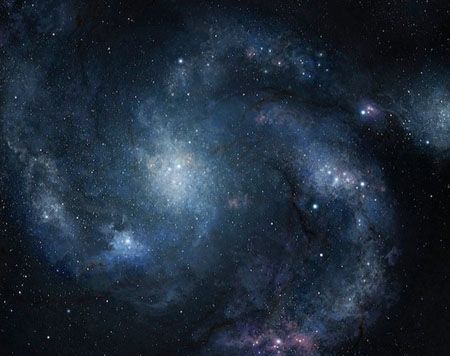 |
The vast majority of old galaxies look like train wrecks...Our first thought was, why is this one so different, and so beautiful?And University of Toronto's David Law, who authored the study, comments:
The fact that this galaxy exists is astounding. Current wisdom holds that such ‘grand-design' spiral galaxies simply didn't exist at such an early time in the history of the universe.At the View From the Right, the sentiments are different. Lawrence Auster writes:
What a dumb, vulgar thing to say [that vast majority of old galaxies look like train wrecks] about objects ten billion years old, a hundred thousand light-years across, and each containing hundreds of billions or even tens of trillions of stars. No scientist in 1950 or 1970 would have said it...I think that people, modern, liberal people (which is the majority of the West now) have no principles with which to guide their observations of the world around them.
Far too often, scientists, like their fellow elites in contemporary liberated society who believe in nothing higher or truer than the disordered human self, seem to have no sense of appropriateness, no inherent respect for anything, for the isness of anything. They must drag everything down to the commonest level and make it appear to be as messy and meaningless as we ourselves—even objects that are infinitely vaster and older than anything we can conceive, and that express an order of which (notwithstanding scientific theories which claim to explain far more than than they really do explain) we have no idea.
Ugliness rules. In clothing, in films, in art and even in our "representatives" of beauty. I don't think it is a lack of knowledge about beauty. We've developed standards and often unanimous agreement about what constitutes the beautiful. So I'm not going to into the beauty-hater's argument that beauty is relative; beauty can be objectively measured. What's going on is that people are hating beauty. It is a form of envy. If I cannot be beautiful, then why is she beautiful? It is like wealth, or intelligence, or a sense of entitlement to live anywhere one pleases. Spread the wealth, accept I.Q.ers of 91 into Harvard, let everyone from every corner of the world come into the prosperous West. Or youth. Why cannot I be as young (and attractive) as any fifteen-year-old, at my ripe old age of seventy? Such are the mantra of the equal-opportunity narcissists.
So, in order to fit in with their lowered standards, beauty magazines are (actually they have been, for decades now) publicizing ugliness in their fashion shoots, their models, and even with the "celebrities" and film actors they promote. There was a time when actresses like Elizabeth Taylor, Ingrid Bergman, Grace Kelly and many more appeared in immaculate clothing, looking ethereally beautiful, at any age. And we admired them.
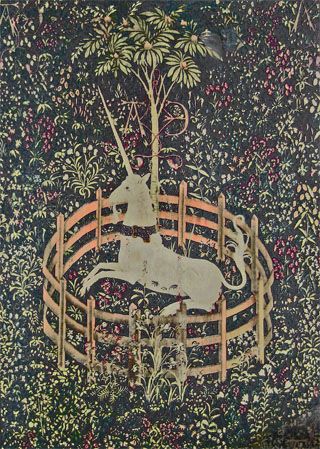 |
I have never been to The Cloisters, but have always known that they house the beautiful tapestries The Hunt of the Unicorn. But, I was lucky to see another set of unicorn tapestries, The Lady and the Unicorn (La Dame à la Licorne), housed in the Musée de Cluny, in Paris.And from my article:
One of the most enchanting mergers of scientific observation and religious symbolism are the tapestries of the Hunt of the Unicorn. These tapestries are covered with the late Medieval tradition of fields of millefleurs. When analyzed carefully, many of these flowers are clearly identifiable, in their correct environment. The Madonna Lily, depicted in The Unicorn in Captivity tapestry, is both a religious symbol of the purity of Mary and also a medicinal plant that treated burns, ulcers and ear infections, amongst other things.Finally, I got to see them during my trip in New York this past August. I tried to take photos (without my flash, as instructed by the guards), but couldn't come up with any decent images, so I had to make do with a postcard of The Unicorn in Captivity from the gift shop.
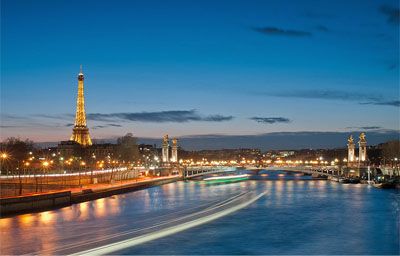 |
The blue hour comes from the French expression l'heure bleue, which refers to the period of twilight each morning and evening where there is neither full daylight nor complete darkness. The time is considered special because of the quality of the light at this time of day.The Wikipedia site has other interesting pieces of information, including art, books, films and music which use l'heure bleue.
Wikipedia continues with a more metaphoric meaning:
The phrase is also used to refer to Paris immediately prior to World War I, which was considered to be a time of relative innocence.
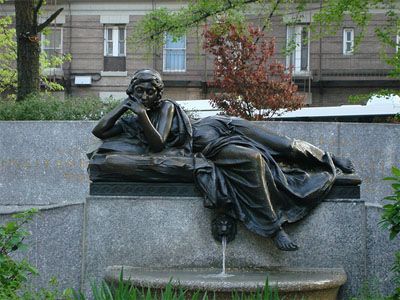 |
Lovely and pleasant were they in their livesThe quote is a strange and obscure one. It tells the relationship between a father and a son (Saul and Jonathan), whereas the memorial is dedicated to a married couple.
And in their death they were not divided
II Samuel 1:23
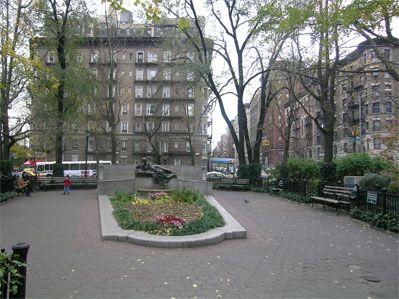 |
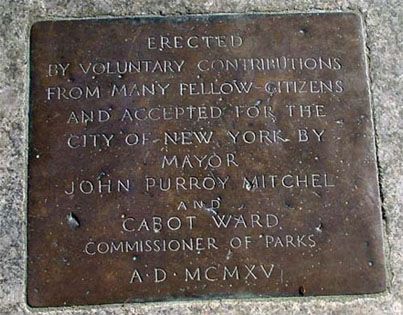 |
 |
Isidor Straus (February 6, 1845 – April 15, 1912), a German-American, was co-owner of Macy's department store with his brother Nathan. He also served briefly as a member of the United States House of Representatives. He died with his wife, Ida, in the sinking of the passenger ship RMS Titanic.
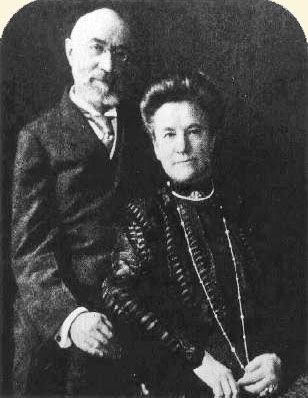 |
 |
 |
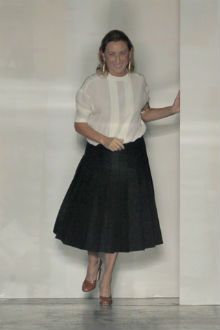 |
Hi ____,
I read a little while ago your post on beauty with interest.
Beauty is a hard concept to "analyze" and to "deconstruct" as leftists love to do. It is an ethereal presence. We react to beauty rather than coldly observe it. We have to admit it is there in some things, probably not in us, and thus we realize it is some kind of favored state (it is clear that beautiful people, and babies, are treated better than ordinary people). At our best, we are humbled by beauty.
This hierarchy of beauty is what grates liberals and leftists.
I've written several (many) blogs on beauty, and I've noticed that there is an even more vicious war going on against beauty than when I started my blog a few years ago. This time, I think people are well-versed on how to attack beauty, and how to make beautiful people, things, etc. feel they're doing, and are, something wrong (and evil). Decades (even centuries, if you look back at the origins of modernism) have made such people adept attackers of beauty.
I wrote this post on Prada's really ugly clothes after I saw the exhibition "Schiaparelli & Prada, Impossible Conversations" at the Metropolitan Museum. Schiaparelli, in her time (around the turn of the 20th century), was considered a radical fashion designer, yet her least feminine designs are not as viciously ugly as Prada's. Schiaparelli was also much more talented, skilled (trained, I think) than Prada, and she admits the power of femininity and feminine beauty.
Prada is the post-modern feminist who seems to have a visceral hate for femininity. and feminine beauty, and ultimately beauty in general (I won't go into the many viciously anti-woman homosexual designers, since perhaps their deficiencies are obvious, but the heterosexual, female Prada is the ultimate betrayer.)
Prada of course supports all the evils that come with feminism, yet her life is strangely traditional, with a husband of several decades, two grown sons, and one son who is following her footsteps in her fashion design empire. She herself inherited this already successful empire from her father and grandfather, so she hardly qualifies as a female empire builder. She holds her temperamental husband at bay by giving him the high profile role of managing her company (and metaphorically, her too?). She's a clever, smart feminist. Those are the types that really do rule this world, since they realize that the female energy IS different than the male's. So, what they're after in not equality, but a reversal of roles (of power), even though they know from experience that this isn't likely to happen. But, I think even clever, smart Prada succumbs to her illusions, since her inner-most desire must be (from all the information she keeps giving us) to make women the superior sex. I think one of your correspondents called this envy. I think that is what it is. The natural, obvious, strength (power) of men, which they carry with such ease, is something to be admired, just as beauty is to be admired in beautiful women. When this admiration is perverted, it turns to something ugly like envy. I think we are in the age of perversions. And this is manifested, at least in my observations of culture, in the cult of ugliness as a vicious retaliation against beauty, and I think related to that (since it all presents itself as equality) the cult of male feminization, which is part of the degradation masculinity.
And finally, what happens if a woman can no longer be beautiful? The alternative now is that she has to look masculine. How does Prada reconcile all that with her "hatred" of masculinity AND femininity? One way is that modern fashion designers (and artists in general) who still work with/for/about women are creating alien monsters, neither male nor female. But, this is something I've just began to observe, and I still have to think about it some more.
Kidist
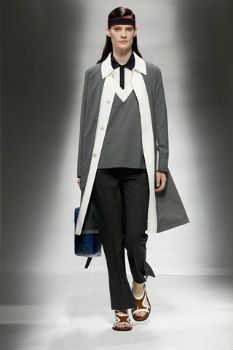 |
I didn't know how to put these unrelated photos (below) in one posting, but they are really connected through the thread of my walk down York Street, all the way to the lake shore.
I planned to do two things during this walk. One was to walk down to the waterfront and take early summer photos of the lake. The water is not the usual hazy pale blue, which is the color it gets later in the summer when the lake has warmed up, but a colder, darker blue with plenty of waves.
The second plan was to keep walking back up to the Art Gallery of Ontario, which is a little further north (and west) to see the Picasso exhibition, for which I had bought a half price ticket (at $12.50, it is a bargain), and also to visit the gallery's permanent collections during the Wednesday nights free entry (from 6pm-8:30pm). I reckoned I would rush through Picasso in half an hour and go to the various permanent collection galleries until the gallery closed. Which is exactly what I did. I will write about both of these visits soon (but Picasso's will be brief, as you can see I am NO fan, but I had to see this "event" in Toronto considering I have an art blog).
In the meantime, below are some photos I took on my way down (with a couple of detours here and there).
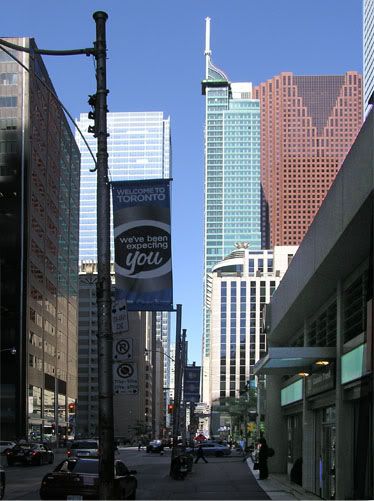 |
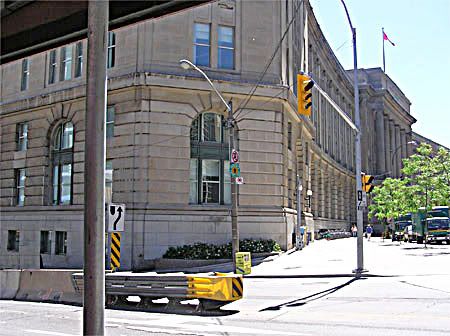 |
 |
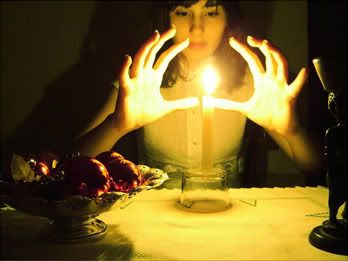 |
As I well remember from my own experience, moderns and progressives like to imagine that they are hard-nosed, rational, empirical. Yet magical thinking abounds.And he heads his sections with: Education, Immigration, Economics, and somewhere in the middle he writes,
The magical thinking of modernity is pernicious because it chucks out the natural spontaneous transcendentalism that is intrinsic to humans - chucks out the soul, gods or God, the reality of reality and The Good (objective truth, objective virtue, objective beauty) - regards these as so much arbitrary made-up stuff, disproven, left-behind, naive, silly, embarrassing...
Then modernity makes-up new stuff, lots of new stuff, ever more and newer stuff; a truly arbitrary and unfounded set of assumptions; then extrapolates unconstrainedly from these assumptions, and then builds systems which are insufficiently systematic to cohere - and then regards the end result, this random heap of constantly-changing nonsense, as real!
So modernity regards education, immigration and economics as real; and the common sense natural way of thinking of historical humankind and the majority of the world (even now) and the views of the non-intellectuals as being childish nonsense.
Modernity disbelieves in magic, yet establishes magical thinking as the unchallengeable core of modernity.
 |
 |
 |
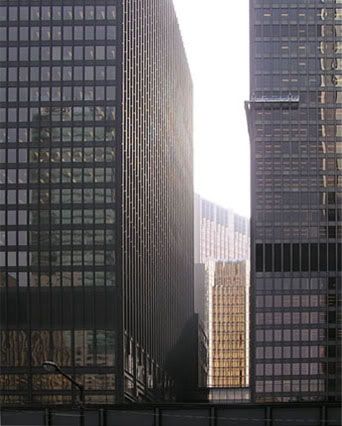 |
In photography, the golden hour (sometimes known as magic hour, especially in cinematography) is the first and last hour of sunlight during the day, when a specific photographic effect is achieved due to the quality of the light.The above shot is nowhere close to this moment. It was taken around mid-day. I have taken many shots of the Mies van der Rohe building. Its strong, metal structure gives modernism a good and dignified name. Glowing in the background is the Royal Bank building, whose luminescence is accentuated by the dark towers in the foreground, making the moment a "golden hour" in its own right.